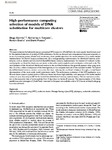Mostrar o rexistro simple do ítem
High-performance computing selection of models of DNA substitution for multicore clusters
| dc.contributor.author | Darriba, Diego | |
| dc.contributor.author | Taboada, Guillermo L. | |
| dc.contributor.author | Doallo, Ramón | |
| dc.contributor.author | Posada, David | |
| dc.date.accessioned | 2018-08-28T10:05:40Z | |
| dc.date.available | 2018-08-28T10:05:40Z | |
| dc.date.issued | 2014 | |
| dc.identifier.citation | DARRIBA, Diego, et al. High-performance computing selection of models of DNA substitution for multicore clusters. The International Journal of High Performance Computing Applications, 2014, vol. 28, no 1, p. 112-125. | es_ES |
| dc.identifier.issn | 1094-3420 | |
| dc.identifier.issn | 1741-2846 | |
| dc.identifier.uri | http://hdl.handle.net/2183/20978 | |
| dc.description.abstract | [Abstract] This paper presents the high-performance computing (HPC) support of jModelTest2, the most popular bioinformatic tool for the statistical selection of models of DNA substitution. As this can demand vast computational resources, especially in terms of processing power, jModelTest2 implements three parallel algorithms for model selection: (1) a multithreaded implementation for shared memory architectures; (2) a message-passing implementation for distributed memory architectures, such as clusters; and (3) a hybrid shared/distributed memory implementation for clusters of multicore nodes, combining the workload distribution across cluster nodes with a multithreaded model optimization within each node. The main limitation of the shared and distributed versions is the workload imbalance that generally appears when using more than 32 cores, a direct consequence of the heterogeneity in the computational cost of the evaluated models. The hybrid shared/distributed memory version overcomes this issue reducing the workload imbalance through a thread-based decomposition of the most costly model optimization tasks. The performance evaluation of this HPC application on a 40-core shared memory system and on a 528-core cluster has shown high scalability, with speedups of the multithreaded version of up to 32, and up to 257 for the hybrid shared/distributed memory implementation. This can represent a reduction in the execution time of some analyses from 4 days down to barely 20 minutes. The implementation of the three parallel execution strategies of jModelTest2 presented in this paper are available under a GPL license at http://code.google.com/jmodeltest2. | es_ES |
| dc.description.sponsorship | European Research Council; ERC-2007-Stg 203161-PHYGENOM to D.P. | es_ES |
| dc.description.sponsorship | Ministerio de Ciencia y Educación; BFU2009-08611 to D.P. | es_ES |
| dc.description.sponsorship | Ministerio de Ciencia y Educación; TIN2010-16735 to R.D. | es_ES |
| dc.language.iso | eng | es_ES |
| dc.publisher | Sage Publications Ltd. | es_ES |
| dc.relation.uri | https://doi.org/10.1177/1094342013495095 | es_ES |
| dc.subject | High-Performance computing (HPC) | es_ES |
| dc.subject | Multicore clusters | es_ES |
| dc.subject | Message-Passing in Java (MPJ) | es_ES |
| dc.subject | Phylogeny | es_ES |
| dc.subject | Nucleotide substitution | es_ES |
| dc.subject | Performance evaluation | es_ES |
| dc.title | High-performance computing selection of models of DNA substitution for multicore clusters | es_ES |
| dc.type | info:eu-repo/semantics/article | es_ES |
| dc.rights.access | info:eu-repo/semantics/openAccess | es_ES |
| UDC.journalTitle | The International Journal of High Performance Computing Applications | es_ES |
| UDC.volume | 28 | es_ES |
| UDC.issue | 1 | es_ES |
| UDC.startPage | 112 | es_ES |
| UDC.endPage | 125 | es_ES |
| dc.identifier.doi | 10.1177/1094342013495095 |
Ficheiros no ítem
Este ítem aparece na(s) seguinte(s) colección(s)
-
GI-GAC - Artigos [189]






